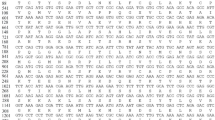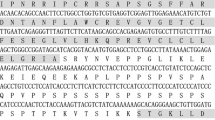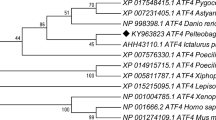Abstract
Roles of p53 in mammals have been extensively studied but little is known about its functions in lower vertebrates. We have cloned and characterized the p53 gene from tilapia (Oreochromis niloticus), expressed it in Escherichia coli, generated a rabbit polyclonal antibody and examined the gene’s expression patterns at both transcript and protein levels. The full-length p53 cDNA was 1288 bp with an ORF of 1,138 bp, encoding a polypeptide of 364 amino acids. The gene contains all four classical p53 family signature motifs but has low sequence similarity with other p53 genes. It was constitutively transcribed in all tissues examined, most abundantly in liver and blood cells. In addition, ATM, p53 and Bax proteins, associated with DNA damage responses and apoptosis, were all upregulated in tilapia liver after treatment with the stress inducers etoposide and CdCl2. Tilapia p53 is thus both a constitutive and inducible acute-phase protein that is cooperatively activated via the ATM-p53 pathway in responses to stress and DNA-damaging signals.





Similar content being viewed by others
References
Berghmans S, Murphey RD, Wienholds E, Neuberg D, Kutok JL, Fletcher CD, Morris JP, Liu TX, Schulte-Merker S, Kanki JP, Plasterk R, Zon LI, Look AT (2005) Tp53 mutant zebrafish develop malignant peripheral nerve sheath tumors. Proc Natl Acad Sci USA 102:407–412
Brady CA, Attardi LD (2010) P53 at a glance. J Cell Sci 123:2527–2532
Brooks CL, Gu W (2003) Ubiquitination, phosphorylation and acetylation: the molecular basis for p53 regulation. Curr Opin Cell Biol 15:164–171
Brzuzan P, Wozny M, Ciesielski S, Luczynski MK, Gora M, Kuzminski H, Dobosz S (2009) Microcystin-LR induced apoptosis and mRNA expression of p53 and cdkn1a in liver of whitefish (Coregonus lavaretus L.). Toxicon 54:170–183
Cachot J, Galgani F, Vincent F (1998) cDNA cloning and expression analysis of flounder p53 tumour suppressor gene. Comp Biochem Physiol B Biochem Mol Biol 121:235–242
Caron de Fromentel C, Pakdel F, Chapus A, Baney C, May P, Soussi T (1992) Rainbow trout p53: cDNA cloning and biochemical characterization. Gene 112:241–245
Chernov MV, Ramana CV, Adler VV, Stark GR (1998) Stabilization and activation of p53 are regulated independently by different phosphorylation events. Proc Natl Acad Sci USA 95:2284–2289
Devlin HL, Mack PC, Burich RA, Gumerlock PH, Kung HJ, Mudryj M, White RWD (2008) Impairment of the DNA repair and growth arrest pathways by p53R2 silencing enhances DNA damage-induced apoptosis in a p53-dependent manner in prostate cancer cells. Mol Cancer Res 6:808–818
Hennequin C, Quero L, Favaudon V (2011) DNA repair and tumour radiosensitivity: focus on ATM gene. Bull Cancer 3:239–246
Kotipatruni RR, Dasari VR, Veeravalli KK, Dinh DH, Fassett D, Rao JS (2011) p53- and Bax-mediated apoptosis in injured rat spinal cord. Neurochem Res 11:2063–2074
Kruse JP, Gu W (2009) Modes of p53 regulation. Cell 137:609–622
Lee KC, Goh WL, Xu M, Kua N, Lunny D, Wong JS, Coomber D, Vojtesek B, Lane EB, Lane DP (2008) Detection of the p53 response in zebrafish embryos using new monoclonal antibodies. Oncogene 27:629–640
Liu M, Tee C, Zeng F, Sherry JP, Dixon B, Bols NC, Duncker BP (2011) Characterization of p53 expression in rainbow trout. Comp Biochem Physiol C Toxicol Pharmacol 154:326–332
Luft JC, Bengten E, Clem LW, Miller NW, Wilson MR (1998) Identification and characterization of the tumor suppressor p53 in channel catfish (Ictalurus punctatus). Comp Biochem Physiol B Biochem Mol Biol 120:675–682
Mai WJ, Yan JL, Wang L, Zheng Y, Xin Y, Wang WN (2010) Acute acidic exposure induces p53-mediated oxidative stress and DNA damage in tilapia (Oreochromis niloticus) blood cells. Aquat Toxicol 100:271–281
Olivier M, Hollstein M, Hainaut P (2010) TP53 mutations in human cancers: origins, consequences, and clinical use. Cold Spring Harb Perspect Biol 2:1000–1008
Rau Embry M, Billiard SM, Di Giulio RT (2006) Lack of p53 induction in fish cells by model chemotherapeutics. Oncogene 25:2004–2010
Singh R, Kaur B, Sram RJ, Binkova B, Kalina I, Popov TA, Garte S, Taioli E, Farmer PB (2004) Effects of environmental air pollution on endogenous oxidative DNA damage. Mutagenesis 19:519
Tedeschi A, Di Giovanni S (2009) The non-apoptotic role of p53 in neuronal biology: enlightening the dark side of the moon. EMBO Rep 10:576–583
Warmerdam DO, Kanaar R (2010) Dealing with DNA damage: relationships between checkpoint and repair pathways. Mutat Res 704:2–11
Yu X, Sidhu JS, Hong S, Robinson JF, Ponce RA, Faustman EM (2011) Cadmium induced p53-dependent activation of stress signaling, accumulation of ubiquitinated proteins, and apoptosis in mouse embryonic fibroblast cells. Toxicol Sci 120:403–412
Acknowledgments
This research was supported by the National Science Foundation for Young Scientists of China (Grant No. 31001132), China Postdoctoral Science Foundation (Grant No. 20110491364) and the Jiangsu University Senior Professional Science Foundation (10JDG075).
Author information
Authors and Affiliations
Corresponding author
Electronic supplementary material
Below is the link to the electronic supplementary material.
Rights and permissions
About this article
Cite this article
Mai, Wj., Liu, P. & Wang, W. Characterization of the tilapia p53 gene and its role in chemical-induced apoptosis. Biotechnol Lett 34, 1797–1805 (2012). https://doi.org/10.1007/s10529-012-0980-x
Received:
Accepted:
Published:
Issue Date:
DOI: https://doi.org/10.1007/s10529-012-0980-x




